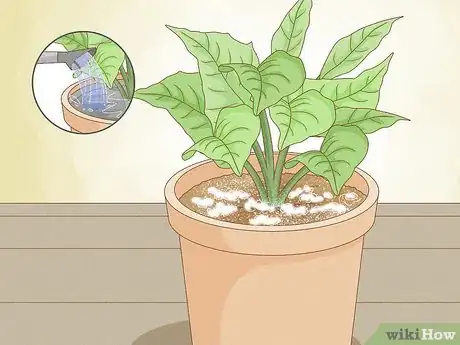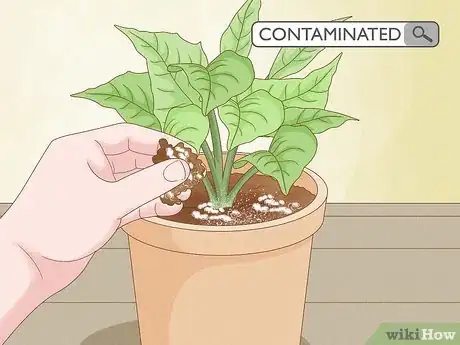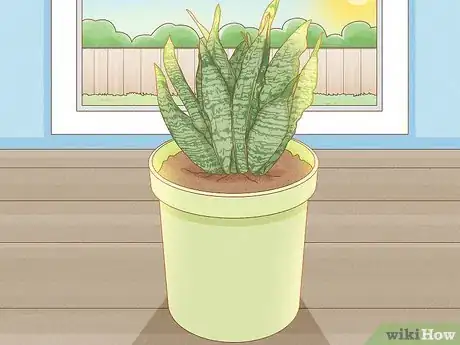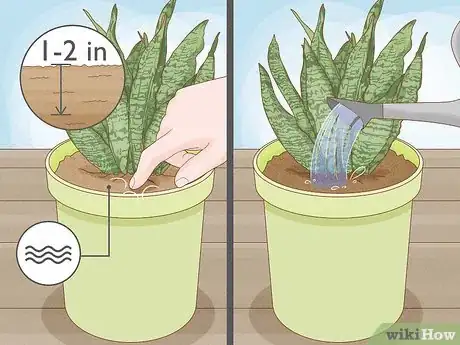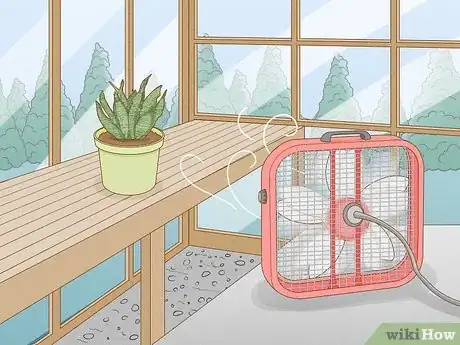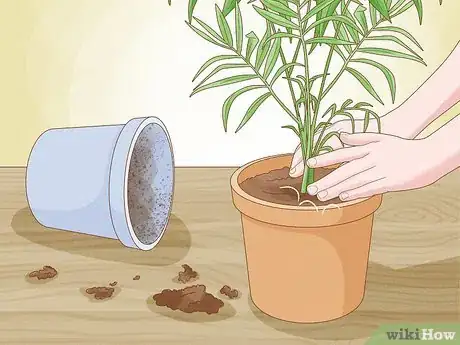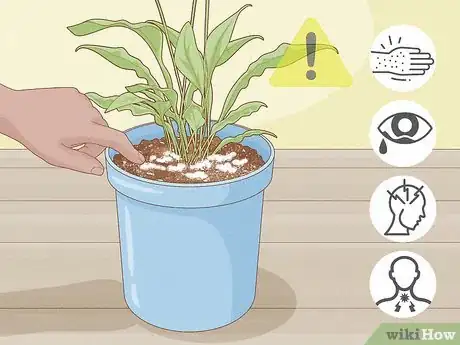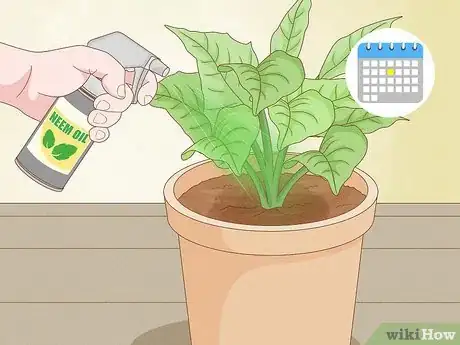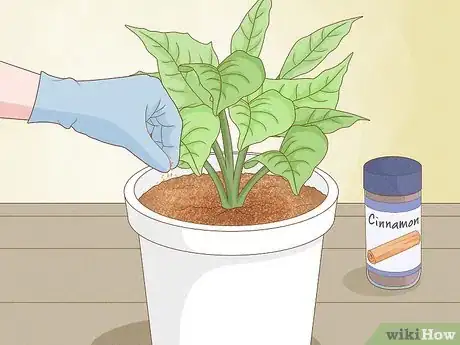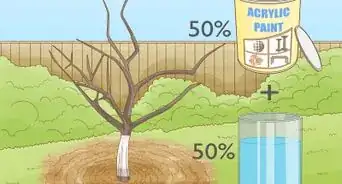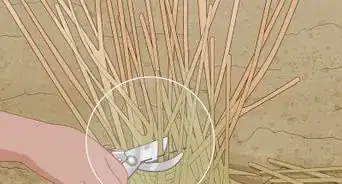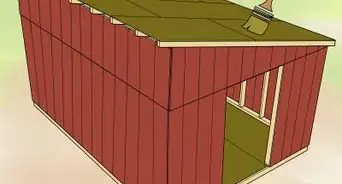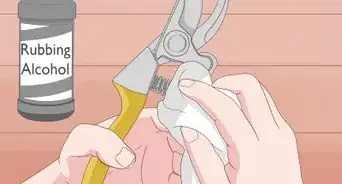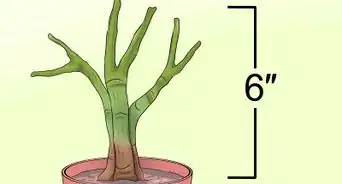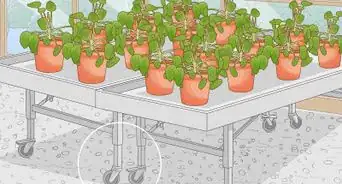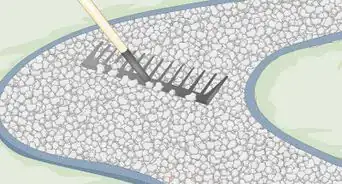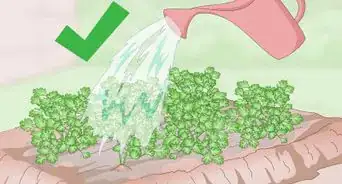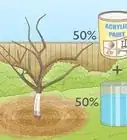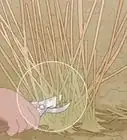This article was co-authored by Chai Saechao and by wikiHow staff writer, Hannah Madden. Chai Saechao is the Founder and Owner of Plant Therapy, an indoor-plant store founded in 2018 based in San Francisco, California. As a self-described plant doctor, he believes in the therapeutic power of plants, hoping to keep sharing his love of plants with anyone willing to listen and learn.
There are 11 references cited in this article, which can be found at the bottom of the page.
This article has been viewed 12,888 times.
Spotting mold growing on top of your beautiful houseplant's soil is never a welcome surprise. Moldy soil isn’t uncommon, and it's usually easy to get rid of. Keep reading to learn why your plant soil has mold in the first place, what you can do about it, and how to keep it from coming back.
Steps
What are the causes of mold in houseplant soil?
-
1Overwatering. Usually, a white, powdery mold or mildew will form on the top layer of soil because it’s staying too moist for too long.[1] Some plants need less water than others, so be sure to look into how much water your specific plant needs.[2]
- Mold and mildew are both caused by a fungus that thrives in warm, wet environments.[3]
-
2Poor drainage. If the excess water can’t drain out, it’s going to cause a buildup of moisture, which can lead to mold. Make sure your plant is in a pot with a drainage hole in the bottom. If it's not, repot it. That way, any water that isn’t absorbed by the soil will drain out of the pot instead of sitting and leading to mold growth.[4]Advertisement
-
3Infected potting soil. Although potting soil is supposed to be completely sterile, that’s rarely ever the case. If your potting soil had some mold in it already, that could be why you’re noticing it in your plant soil now.[5]
How do you get rid of mold in houseplant soil?
-
1Scoop away the infected soil with a clean spoon. Usually, the mold is only on the top layer of soil. When you notice it, grab a clean spoon from your silverware drawer and scoop up the infected soil.[6] Throw the soil away in the garbage, not your compost, to avoid contaminating any other plants.[7]
- If you have to scoop out a lot of soil, add another layer of topsoil or potting soil to the plant.
-
2Put your plant in a sunny area. Powdery mold and mildew thrives in dark, dank places. If you put your plant in the sun, the soil will dry out more, making it harder for the mildew to thrive. Try placing your plant near a window so it has time to really dry out during the day.[8]
- Some plants can tolerate direct sunlight, while others can’t. Be sure to look into your specific plant’s needs before putting it in your window.
How do you prevent new mold growth?
-
1Wait until the soil dries out before watering again. Since overwatering is the main cause of mold, try to cut back your watering schedule just a little. Experts recommend waiting until the top 1 to 2 in (2.5 to 5.1 cm) of soil is completely dry for most houseplants.[9]
- This is a good rule of thumb for most plants, but not all of them. Look into your specific plant and how much water it needs to ensure you aren’t overwatering it.
-
2Run fans near your plant to improve air flow. Sometimes, soil grows mold because it’s too humid. You can improve air flow and stop moisture from building up by pointing a fan near your plant and leaving it on. This is especially effective in small, warm spaces, like greenhouses.[10]
-
3Repot the plant with fresh soil if the mold doesn’t go away. It’s not common, but sometimes, mold really sticks around. If you’ve scooped out the mold once before and it keeps coming back, dump out the infected soil into the trash and rinse out the pot. Then give your plant a fresh pot of soil to sit in. Hopefully, the new soil won’t have any mold problems.[11]
What is a natural antifungal for plants?
-
1Neem oil. Neem oil is a natural oil that’s made from a neem tree, and studies show that it has antifungal properties.[13] If you find that your soil or your plants are constantly battling fungus, pick up a bottle of neem oil and follow the dilution instructions on the back of the bottle.[14] Then, spray your plants and your soil with neem oil once a month to prevent mold and fungus.[15]
- Neem oil is safe to use around pets and children, but it’s slightly toxic to birds and fish.
-
2Cinnamon. Research suggests that cinnamon can be used as a natural antifungal agent.[16] To use cinnamon, sprinkle it over your soil and then work it into the top layer to prevent mold, fungus, and insects.
Expert Q&A
-
QuestionWhy does mold grow in the soil?
 Chai SaechaoChai Saechao is the Founder and Owner of Plant Therapy, an indoor-plant store founded in 2018 based in San Francisco, California. As a self-described plant doctor, he believes in the therapeutic power of plants, hoping to keep sharing his love of plants with anyone willing to listen and learn.
Chai SaechaoChai Saechao is the Founder and Owner of Plant Therapy, an indoor-plant store founded in 2018 based in San Francisco, California. As a self-described plant doctor, he believes in the therapeutic power of plants, hoping to keep sharing his love of plants with anyone willing to listen and learn.
Plant Specialist Usually, mold grows due to over-watering. It means that the soil is too moist.
Usually, mold grows due to over-watering. It means that the soil is too moist. -
QuestionWhat should I do if there is mold in the soil?
 Chai SaechaoChai Saechao is the Founder and Owner of Plant Therapy, an indoor-plant store founded in 2018 based in San Francisco, California. As a self-described plant doctor, he believes in the therapeutic power of plants, hoping to keep sharing his love of plants with anyone willing to listen and learn.
Chai SaechaoChai Saechao is the Founder and Owner of Plant Therapy, an indoor-plant store founded in 2018 based in San Francisco, California. As a self-described plant doctor, he believes in the therapeutic power of plants, hoping to keep sharing his love of plants with anyone willing to listen and learn.
Plant Specialist You can remove the moldy soil. Check the plant and put some neem oil on it. The oil will prevent the occurrence of mold.
You can remove the moldy soil. Check the plant and put some neem oil on it. The oil will prevent the occurrence of mold.
References
- ↑ Chai Saechao. Plant Specialist. Expert Interview. 28 June 2019.
- ↑ https://www.bobvila.com/slideshow/12-big-mistakes-that-lead-to-mold-and-mildew-growth-52810
- ↑ https://hgic.clemson.edu/factsheet/houseplant-diseases-disorders/
- ↑ https://www.bobvila.com/slideshow/12-big-mistakes-that-lead-to-mold-and-mildew-growth-52810
- ↑ https://www.canr.msu.edu/news/ask-the-expert-moldy-potting-mix
- ↑ Chai Saechao. Plant Specialist. Expert Interview. 28 June 2019.
- ↑ https://www.bobvila.com/slideshow/12-big-mistakes-that-lead-to-mold-and-mildew-growth-52810
- ↑ https://hgic.clemson.edu/factsheet/euonymus-diseases-insect-pests/
- ↑ https://www.bobvila.com/slideshow/12-big-mistakes-that-lead-to-mold-and-mildew-growth-52810
- ↑ https://ag.umass.edu/greenhouse-floriculture/fact-sheets/reducing-humidity-in-greenhouse
- ↑ https://www.apartmenttherapy.com/how-to-fix-gross-houseplant-problems-36826491
- ↑ https://www.health.ny.gov/publications/7287/
- ↑ https://www.ncbi.nlm.nih.gov/pmc/articles/PMC3768785/
- ↑ http://npic.orst.edu/factsheets/neemgen.html
- ↑ Chai Saechao. Plant Specialist. Expert Interview. 28 June 2019.
- ↑ https://www.ncbi.nlm.nih.gov/pmc/articles/PMC3459460/
